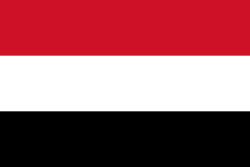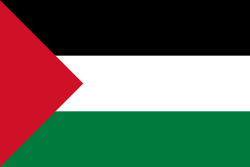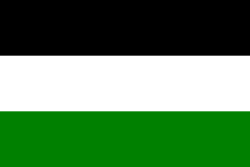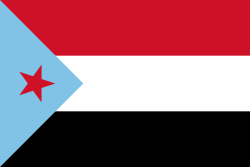
The following is a list of flags used by Yemen throughout its history.

The following is a list of flags used by Yemen throughout its history.
| Flag | Date | Use | Description | Reference(s) |
|---|---|---|---|---|
 | 1990–Present | Flag of the Republic of Yemen | A horizontal triband of red, white and black | [1] [2] [3] [4] [5] |
| Flag | Date | Use | Description | Reference(s) |
|---|---|---|---|---|
 | 1990–Present | Presidential Flag of Yemen | A horizontal triband of red, white and black with the national emblem in the canton. |
| Flag | Date | Use | Description | Reference(s) |
|---|---|---|---|---|
 | 1990–Present | Flag of Aden Region | A horizontal triband of blue, white and blue with a red trapezoid based on the hoist side. | |
 | 1990–Present | Flag of Azal Region | A horizontal bicolor of green and white with the Yemenite tricolor in the white band. | |
 | 1990–Present | Flag of Hadramaut Region | A horizontal triband of green, white and blue with a vertical red stripe on the hoist side and a tree in the center. | |
 | 1990–Present | Flag of Janad Region | A horizontal triband of red, blue and yellow. | |
 | 1990–Present | Flag of Saba Region | A horizontal triband of green (upper), white and green with six golden vertical bars in the center. | |
 | 1990–Present | Flag of Tihama Region | A horizontal triband of light blue, white and green. |
| Flag | Date | Use | Description | Reference(s) |
|---|---|---|---|---|
 | 1990–Present | Flag of the Yemeni Interior Ministry | A blue field with The Ministry's Emblem in the center. | |
 | 1964–Present | Flag of the Yemeni Republican Guard | A diagonal bicolor of orange and blue with the Republican Guard's emblem in the center. | |
 | 1980–Present | Flag of the Yemeni Special Security Forces | A blue field with The Security Forces' emblem in the center. | |
 | 1990–Present | Flag of the Yemeni Armed Forces | A horizontal triband of red, white and black with the Armed Forces' emblem in the canton corner. | |
 | 1990–Present | Flag of the Yemeni Army | A red field with the national flag in the canton corner, and the Emblem of the Yemeni Armed Forces centered on the fly side. | |
 | 1990–Present | Flag of the Yemeni Navy | A blue field with the national flag in the canton corner, and the emblem of the Yemeni Navy centered on the fly side. | |
 | 1990–Present | Flag of the Yemeni Air Force | A sky blue field with the national flag in the canton corner, and the emblem of the Yemeni Air Force centered on the fly side. |
| Flag | Date | Use | Description | Reference(s) |
|---|---|---|---|---|
 | 1978–Present | Flag of the Yemeni Socialist Party | A light blue field with a red star in the center. | |
 | 1982–Present | Flag of the General People's Congress | A blue field with a brown horse in the center. | |
 | Flag of the Yemeni Congregation for Reform (Islah) Party | A dark blue field with a white sun shining in the center. | ||
 | 1951–Present | Flag of the Ba'ath Party | A horizontal triband of black, white and green with a red triangle on the hoist side. | |
 | 1994–Present | The Sarkha of the Houthis | A white field with a green border and a green and red Arabic script. |
| Flag | Date | Use | Description | Reference(s) |
|---|---|---|---|---|
 | 1918 - 1923 | Flag of the Kingdom of Yemen | A simple red field | |
 | 1923 - 1927 | Flag of the Kingdom of Yemen | A red field with a white Shahadah | |
 | 1927 - 1970 | Flag of the Kingdom of Yemen | A red field with five stars and a sword in the center. |
| Flag | Date | Use | Description | Reference(s) |
|---|---|---|---|---|
 | 1636 - 1930 | Flag of the Baidah Sultanate | A horizontal triband of white, red and black with a crescent moon in the canton. |
| Flag | Date | Use | Description | Reference(s) |
|---|---|---|---|---|
 | 1728–1967 | Flag of the Sultanate of Lahej | A vertical bicolor of red and white with 2 crossed Jambiyas and a spear on the red stripe. |
| Flag | Date | Use | Description | Reference(s) |
|---|---|---|---|---|
| Flags of The Federation of South Arabia | ||||
 | 1937 - 1963 | Flag of the Aden Colony | A Blue Ensign with the Union Jack at the canton, defaced with the badge of Aden. | |
 | 1962 - 1967 | Flag of the Federation of South Arabia | A horizontal triband of black, green and blue, separated by two golden stripes and a crescent moon with star in the center. | |
 | 1963 - 1967 | Flag of the State of Aden | A horizontal triband of blue (upper), white and blue; with a red trapezium based on the hoist side and a green star in the center. | |
 | 1839 - 1967 | Flag of the Emirate of Beihan | A horizontal triband of brown, green and yellow with a red triangle on the hoist side, which contains a crescent moon inside. | |
 | 1839 - 1967 | Flag of the Emirate of Dhala | A horizontal bicolor of red and green with a black crescent moon and star in the center. | |
 | 1839 - 1967 | Flag of the Fadhli Sultanate | A horizontal triband of black, green and blue with a crescent moon with star in the center. | |
 | 1839 - 1967 | Flag of Lower Yafa | A horizontal triband of black, white and green | |
 | 1872 - 1967 | Flag of the Sultanate of Lahej | A vertical bicolor of red and white with 2 crossed swords and a spear on the red stripe. | |
 | 1839 - 1967 | Flag of Wahidi Haban | A horizontal triband of green, yellow and blue with a red vertical stripe on the hoist side, which contains a crescent moon and star inside and 2 crossed swords in the center. | |
 | 1839 - 1967 | Flag of Dathina | A horizontal bicolor of blue and green with a crescent moon in the center and 3 stars. | |
 | 1839 - 1967 | Flag of Haushabi | A horizontal triband of green, yellow and blue with a red star in the center. | |
| Flags of The Protectorate of South Arabia | ||||
 | 1839 - 1967 | Flag of Kathiri | A horizontal triband of yellow (upper), green and yellow with a red triangle on the hoist side which contains 3 stars inside. | |
 | 1880 - 1939 | Flag of Qu'aiti | A red field with a white stripe on the hoist side. | |
 | 1939 - 1967 | Flag of Qu'aiti | A horizontal triband of red, yellow and blue with 2 blue discs and one green disc which contains 1 tower each disc. | |
 | 1839 - 1967 | Flag of the Mahra Sultanate | A horizontal triband of green, white and red with a black crescent moon and star in the center. | |
 | 1839 - 1967 | Flag of Wahidi Balhaf | A horizontal triband of green, yellow and blue with a red vertical stripe on the hoist side, which contains a crescent moon and star inside. | |
 | 1839 - 1967 | Flag of Upper Yafa | A horizontal bicolor of orange and green with a crescent moon and a sword in the center. | |
| Flag | Date | Use | Description | Reference(s) |
|---|---|---|---|---|
 | 1962 - 1990 | Flag of the Yemen Arab Republic | A horizontal tricolour of red, white, and black with a green five-pointed star in the center. |
| Flag | Date | Use | Description | Reference(s) |
|---|---|---|---|---|
 | 1967–1990 | Flag of South Yemen | A horizontal tricolour of red, white and black with a sky-blue chevron with a tilted red star (the emblem of the Yemeni Socialist Party) next to the hoist. | |
 | 1967–1990 | Presidential flag of South Yemen | A horizontal tricolour of red, white and black with a sky-blue chevron with a tilted red star next to the hoist and the coat of arms in the canton. | |
 | 1978–1990 | Flag of the ruling party |